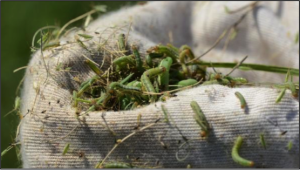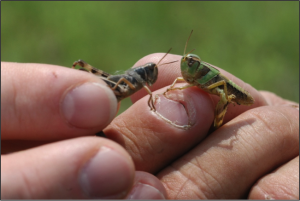Dr. Clark Neely, Statewide Small Grains Extension Specialist, Texas A&M AgriLife Extension
Dr. Allen Knutson, Extension Entomologist, Texas A&M AgriLife Extension
 Figure 1. Armyworms can devastate young wheat plants and decrease fall stands (Texas A&M AgriLife Extension photo).
Figure 1. Armyworms can devastate young wheat plants and decrease fall stands (Texas A&M AgriLife Extension photo).
According to the latest USDA report, Texas has 24% of its winter wheat in the ground, which is behind the normal 34% for this time of year. This is largely due to dry weather conditions intensifying across much of the state. Another source for concern among wheat growers in the High Plains and Rolling Plains are elevated levels of insect pests, primarily grasshoppers and fall armyworms. There are several reports from both Oklahoma and Texas indicating these two pests are attacking young wheat plants across both states. Fall armyworms come in many shades of green, brown, and almost black and are easily distinguished by a white upside-down “Y” on their heads. Damage often appears as tiny “window panes” in the wheat leaves, but entire leaves can be consumed under heavy pressure or with larger larvae over 1” in length. Control is recommended once four or more larvae (1 inch or greater in length) are detected per square foot or when armyworms are destroying the stand on emerging wheat.
There are many species of grasshoppers that can affect wheat and small grains as well in the fall. Populations have built up during the summer months due to dry conditions, which favors grasshopper development. Populations will likely remain high until we experience 1-2 hard freezes this fall. They can be difficult to control because they are generalist feeders and can survive on many kinds of crops and weeds and will often migrate into wheat fields from surrounding pastures and rangeland.
 Figure 2. One of 150 grasshopper species founds in Texas (Photo by Robert Burns).
Figure 2. One of 150 grasshopper species founds in Texas (Photo by Robert Burns).
For both of these pests, it is important to scout early and often following planting for two reasons. First, insecticides are much more effective at controlling young larvae (fall armyworm) and nymphs (grasshopper) and secondly, producers can avoid much of the damage these pests can inflict if controlled early. Fall armyworms can consume 80% of the total foliage they consume in their life cycle in the final two to three days of feeding according to Dr. Allen Knutson, Extension Entomologist.
For more information on scouting and controlling these pests, please refer to Texas A&M AgriLife Extension publication “Managing Insect and Mite Pests of Texas Small Grains” (http://varietytesting.tamu.edu/wheat/otherpublications/Managing%20Insects%20and%20Mite%20Pests%20of%20Texas%20Small%20Grains.pdf) and AgriLife fact sheet titled “The Fall Armyworm – Pest of Pasture and Hay – 2015” (http://cooke.agrilife.org/files/2015/08/Armyworm-Fact-Sheet-2015.pdf).